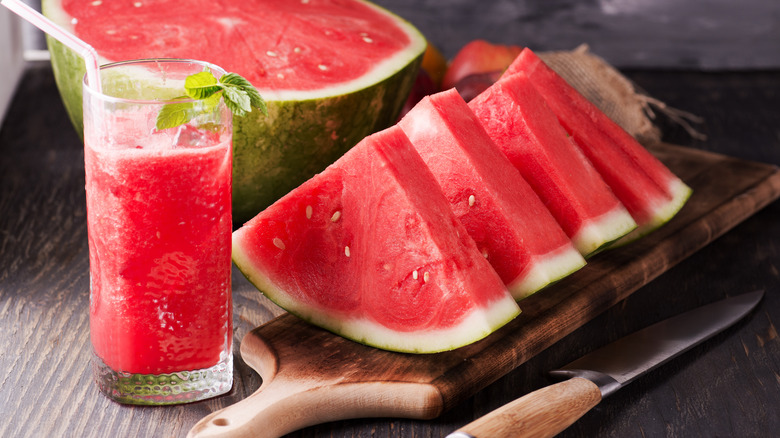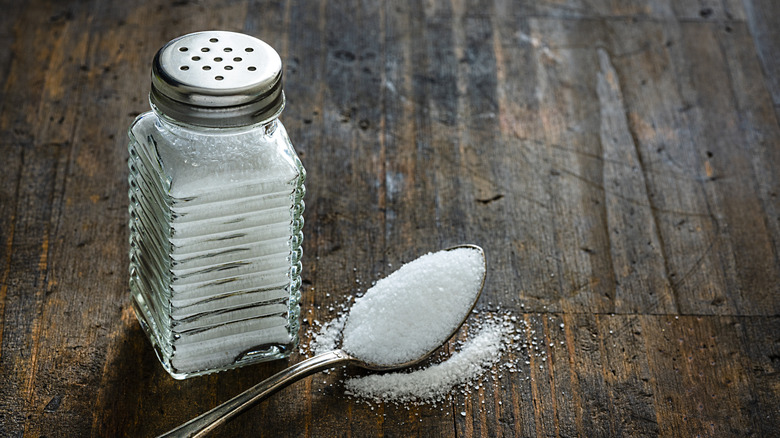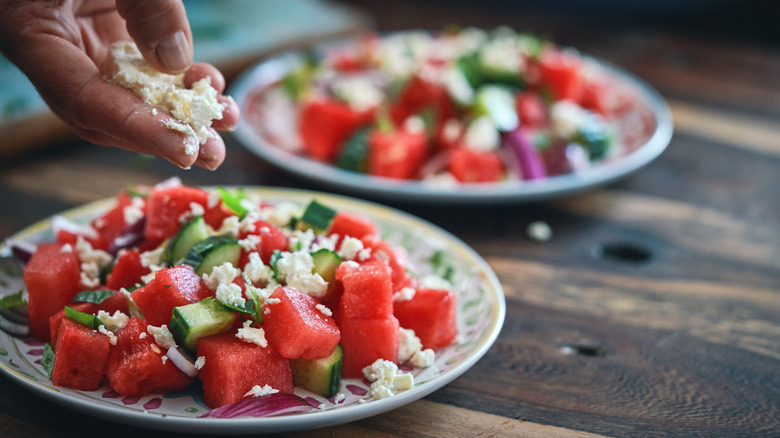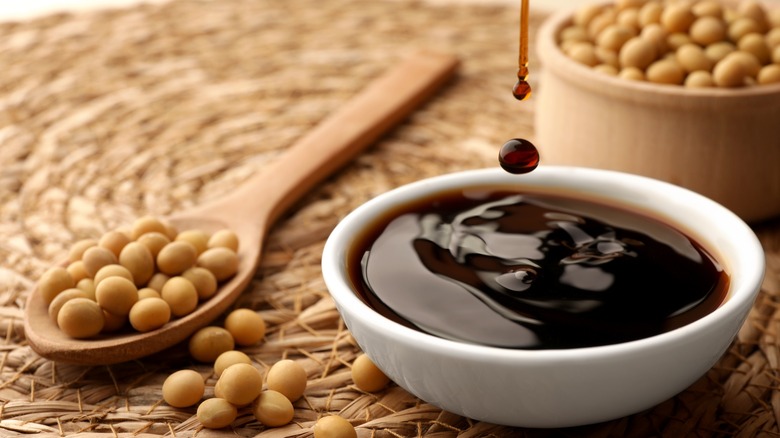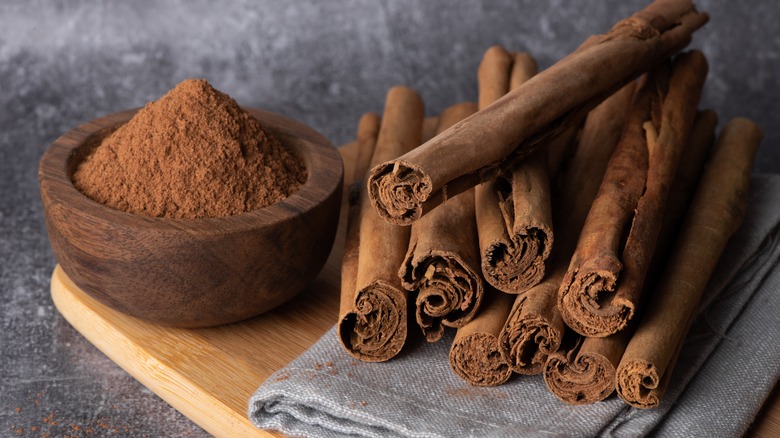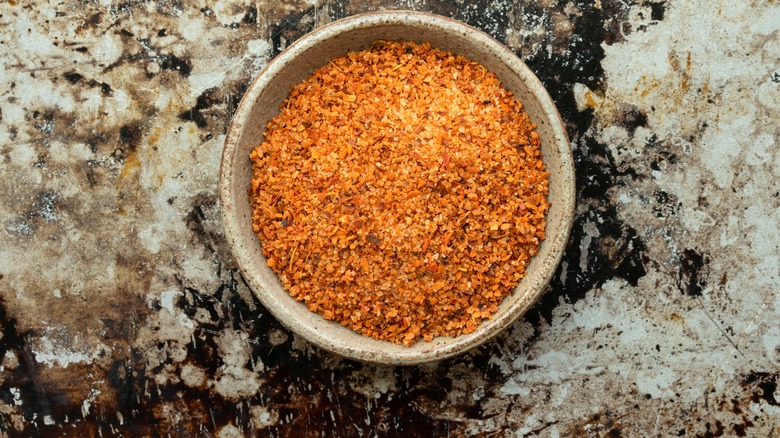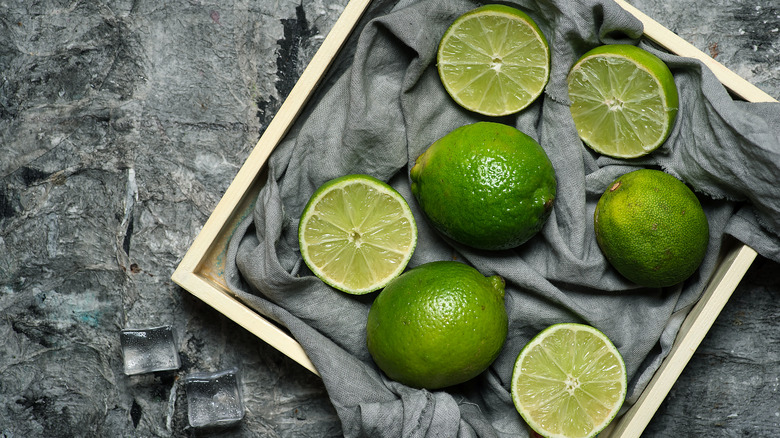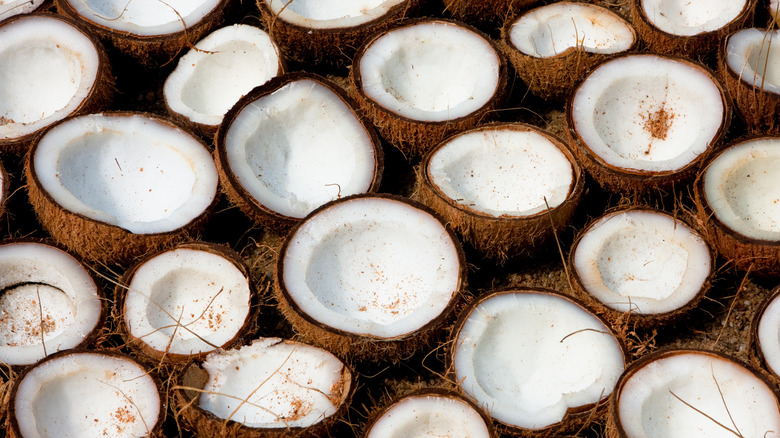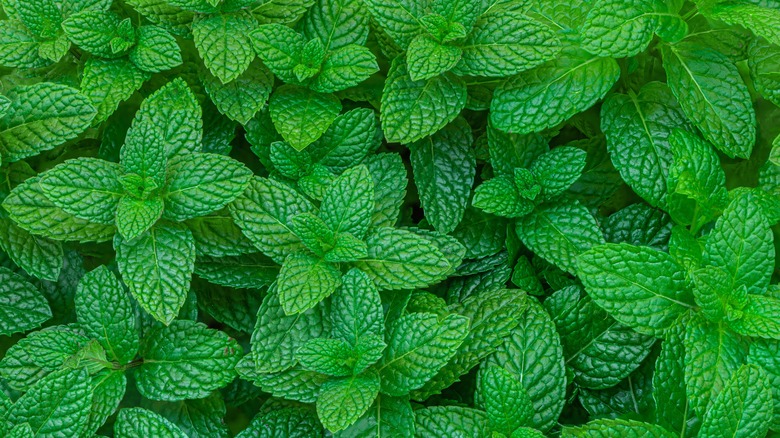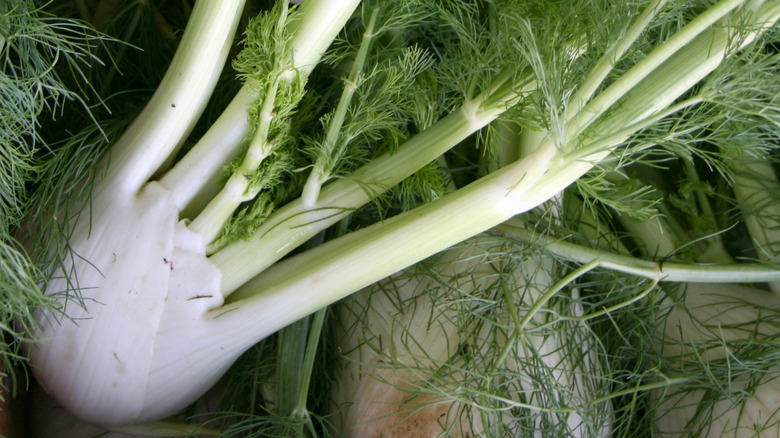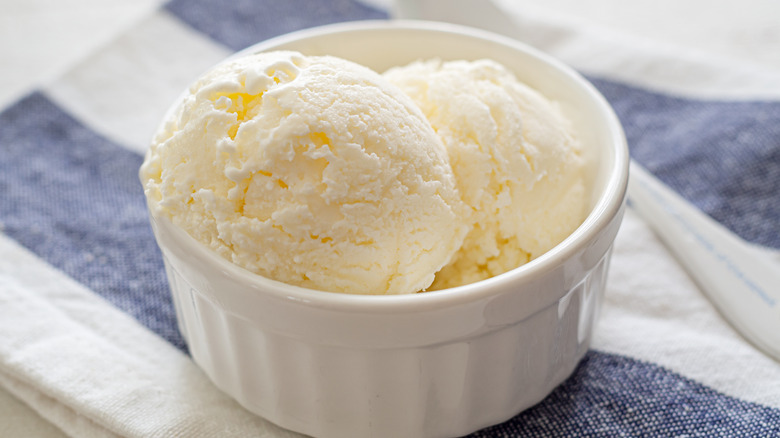Ingredients That Will Save Your Mediocre Watermelons
At its best, watermelon brings the best of all possible worlds: sweet, fragrant, and impossibly juicy, it checks all the boxes for a satisfyingly decadent warm-weather dessert — yet it contains no fat, sodium, or cholesterol. Far from comprising any elements that might present problems down the line, watermelon is loaded with nutrients, including potassium, vitamin A, and vitamin C. And, being 92% water, it serves as an ideal refresher following a long run or a morning spent tending to summer yard work.
However, as many can attest, not every watermelon realizes its full potential. Purchasing it out of season or simply encountering bad luck might result in a watery yet tasteless melon, lacking the depth or sweetness you were hoping for. Disposing of it entirely, even in compost, feels wasteful, especially if you intended to share it with guests. But have no fear: While a lackluster watermelon may never rival its perfectly ripened counterpart, you can enhance its existing flavor and sweetness with judicious seasoning choices, transforming it into a dish you'll be proud to serve and happy to eat.
Salt
Lightly salting watermelon slices is an old Southern tradition, often met with skepticism by those unfamiliar with the practice. Despite the jokes, aficionados from the South will tell you that, strange as it may sound, salt really does work magic on watermelon. Not only does it enhance watermelon's inherent sweetness and overall flavor profile, but it also suppresses the melon's bitter undertones. Salt also stimulates salivation, making the seasoned melon taste even juicier. Moreover, a sprinkle of salt on cold watermelon can replenish electrolytes lost through perspiration, a boon during the oppressive heat of Southern summers, which likely contributed to the tradition's adoption.
The American South is not alone in its appreciation for salted fresh fruit. In Mexico, salt and chile commonly season fresh fruits like mangoes. Salted watermelon is also savored in Japan, while in Hawaii, a salty plum-based condiment frequently accompanies fresh pineapple. More familiar to many Americans is the classic Italian appetizer of prosciutto and cantaloupe, where the salty ham accentuates the melon's sweetness.
Feta cheese
Most Americans grew up enjoying watermelon in sweet preparations, such as fruit salad, or in cocktails like daiquiris and margaritas. Therefore, it's no wonder that underripe watermelon is always such a disappointment. However, historically, watermelon wasn't always the sugary treat we know now. It was first cultivated in Africa before spreading north through the Mediterranean region and then to Europe, and it came in many forms, which suggests the melon has always been a highly adaptable ingredient.
So, historically, watermelon wasn't always considered sweet, nor was it necessarily paired with sweet foods. A preparation that has become popular over the past 20 years, for instance, is watermelon and feta cheese salad. The salty feta provides a pleasant contrast to the sweetness of the watermelon, and even if your melon isn't as sweet or flavorful as you'd like, the salt in the feta will bring out and improve whatever flavor is there.
Sesame, ginger, and soy
A few years ago, internet foodies made a novel observation: When you sprinkle a slice of cucumber with sugar, it tastes startlingly like watermelon. This revelation shouldn't have been much of a surprise, since watermelons and cucumbers are actually members of the same plant family, cucurbits, along with other melons. And if you enjoy melons, you've probably noticed that, despite their differences in color, texture, and relative sweetness, all have a similarly refreshing cucumber-like flavor and aroma to some degree.
So, if sweetening a piece of cucumber yields a flavor somewhat like watermelon, one could argue that an underripe, insufficiently sweet watermelon tastes something like a cucumber, albeit an unusually juicy cucumber with soft red flesh. This means you can either sweeten it to bring it to its expected state, or lean into the savory cucumber vibes and dress it like a cucumber salad. Asian-style cucumber salads often feature a light dressing of soy sauce, sesame oil, and sometimes flavorings such as ginger and/or garlic. Try a similar dressing on your less-than-lovely watermelon to transform it into a surprising and refreshing side dish.
Cinnamon and vanilla
If you bake a lot of sweets, you've likely noticed that almost all recipes call for vanilla extract, regardless of whether vanilla is the primary flavor in the finished product. Even when it's not the main focus, a touch of vanilla in a cake or cookie recipe helps unify all the other flavors, and adds a comforting note of familiarity to everything it touches. So, whether we realize it or not, the flavor and scent of vanilla are indelibly linked to a bounty of baked or cooked sweets.
This makes vanilla an excellent addition when you want to enhance the underlying sweetness in so-so watermelon — a hint of vanilla blends beautifully with watermelon's natural flavors. Even if your watermelon is underripe or a bit bland, vanilla can make it taste more like dessert — and if you're working with a perfectly ripe watermelon, vanilla will make it taste even more decadent. For added dessert pastry vibes, sprinkle your watermelon with a dash of cinnamon as well as a few splashes of vanilla extract — the difference will delight you.
Tajín
If you have roots in Mexico or have spent significant time there, this ingredient is likely a "Well, duh!" inclusion. But if you're unfamiliar with Tajín, you're in for a pleasant surprise: It's the brand name of a ubiquitous Mexican seasoning made of salt, chile, and sour citrus flavors, designed specifically for sprinkling on fresh fruit — its compact, tapered bottle features a shaker top for easy and convenient dispensing.
However, it's not a seasoning for those with timid palates. Tasting it on its own, you'll encounter a potent mix of salt, mouth-puckering sourness, and chile heat. These flavors work to enhance the sweetness of fruit, including watermelon, while adding an extra layer of flavor. But don't worry, it's not overwhelmingly hot: If you're the type to always reach for the hot sauce, the heat will barely register. And used sparingly, it can still add something special — and not overwhelmingly spicy — if you're more interested in flavor than in heat.
Gin
It's no secret that a touch of alcohol can make almost any food feel fancy and festive — and watermelon is no exception. An old trick for transforming an ordinary whole watermelon into memorable adult party fare involves cutting a hole in the rind and gradually pouring in vodka. It seeps invisibly into the melon, turning each slice into a juicy, boozy, chewable cocktail. (Pro tip: To introduce alcohol into a watermelon faster and ensure it's evenly distributed, use a meat injector, and inject the melon at several different spots, allowing it to rest and absorb the liquor between injections.)
However, vodka is not the only spirit that can elevate a dull watermelon. The herbal, floral flavors and aromas of gin add even more punch to bland melons than the mild-mannered vodka. Added to watermelon juice with sliced cucumber and mint muddled together at the bottom of a glass, it creates a cooling and not-too-sweet summer cocktail. Alternatively, you can inject a watermelon with gin instead of vodka to make a refreshingly memorable adult snack.
Lime juice
Citrus is a go-to flavor enhancer for good reason — whether you crave a touch of acidity as a counterpoint to rich fried foods, or seek to add extra aroma and depth to a sauce or dessert, a bit of citrus juice or zest will do the trick. Its compatibility with both savory and sweet foods is another advantage: Keeping a few lemons and limes in your crisper means you have a dependable and easy-to-use solution for dull food at your fingertips.
Among the foods that can be enhanced by citrus is watermelon. The good news is that even the blandest of watermelons has the potential to refresh; it just needs a little help. And the floral notes of fresh lime are just what you need to enhance the flavor and aroma of a dull melon. Try blending cubes of watermelon with lime juice to make a pretty and refreshing watermelon limeade, or sprinkle slices of watermelon with finely grated lime zest and a pinch of salt for a refreshing treat that's more than the sum of its parts.
Honey
There's no greater disappointment than anticipating that first bite of cold, juicy watermelon only to find it lacking in sweetness. You can pivot and add flavorings that will transform your bland melon into an appetizing savory snack, but if you're set on enjoying watermelon as a sugary treat, you can sweeten it. Of course, there are multiple options for doing so. But why just sweeten a dull melon when you can make it into something even better with little or no extra effort?
For this, look to that jar or bottle of honey you almost certainly have in your pantry. The rich, floral notes of honey harmonize well with the flavor of watermelon, and bring out the fruity notes in even the dullest of melons. For a quick snack with extra texture, drizzle honey over a slice of watermelon and top with shelled pistachios. Or, play around with different flavors, and spritz your honey-coated melon with a spritz of lime juice for extra brightness and acidity.
Coconut
In most of our minds, watermelon and warm weather are indelibly linked. There are good reasons for this: Watermelons ripen and taste their best in mid-summer, and their cooling flavor and plentiful juices seem designed to offer refreshment and rehydration on a sweltering day.
So, it's probably no coincidence that watermelon goes well with other summery flavors — and among these is coconut. While not technically a summer food in the U.S., we do associate it (rightfully) with warm climates and sunny weather, just as we do watermelon. And like watermelon, coconut can be taken in either savory or sweet flavor directions, making it a versatile partner when you need something interesting to enliven an imperfect watermelon. For a sweet-savory snack, top a slice of watermelon with coconut flakes and a sprinkling of curry powder. To take it in a sweet direction, make a pretty pink smoothie of watermelon chunks, coconut milk, and vanilla.
Mint
Ask anyone to list a few adjectives describing watermelon, and chances are that one of these — right after "sweet" and "juicy" — will be "cooling" or "refreshing." And while you can cook watermelon and enjoy it warm (in the Middle East, it was historically served cooked, and grilling watermelon adds smokiness, texture, and complexity to the fruit), most diners turn to cold watermelon to help them cool down and rehydrate.
So, if you want to play up the cooling powers of watermelon, especially if you're stuck with a rather bland fruit, you can enhance its flavor and power to refresh with other cooling ingredients. And one that goes especially well with watermelon is fresh mint. Not only do the green leaves offer a pretty color contrast to the red melon flesh, but their cooling, peppery flavor and aroma also make even bland melon fragrant and refreshing. Throw a handful of leaves in a blender with watermelon chunks to make a refreshing drink, or sprinkle some chopped leaves over watermelon pieces or slices for a flavorful summer salad.
Fennel
If you find yourself stuck with a disappointing watermelon, it's not the end of the world. You can easily turn it into something that's not only edible, but actually interesting and tasty, by adding ingredients that either enhance what little flavor is there or create an appealing visual, textural, or flavor contrast. And a surprising ingredient that does all of these on its own is fresh fennel.
If you're unfamiliar with fresh fennel, think of it as an herb that eats like a vegetable. It grows into a pale green bulb topped with fleshy green stalks with feathery fronds—something like a bunch of celery, only swollen at its base. Eaten raw, it has a celery-like crispness and juiciness, but a distinctively refreshing and cooling licorice-like flavor. All of these features — its pretty green color, its crispness, and its unique flavor — make it a gorgeous match for watermelon: It offers contrasts in color and texture to the soft, red melon along with a surprisingly harmonious and unique flavor. Shave a handful of raw fennel into a salad with watermelon, a squeeze of lemon juice, and a sprinkling of ricotta salata.
Ice cream
A perennial — and futile — battle for nutrition-minded parents is trying to convince their kids that fruit can qualify as dessert. After all, it's sweet! But few kids in the history of humanity have ever bought into this argument. Yes, fruit is sweet, and it's a nice thing to find in your lunchbox, but let's get real — there's no way a sliced apple or plain wedge of watermelon can ever compare to the wonders of an ice cream sundae or a slice of cake. And this is especially true if subpar fruit is involved: It's bad enough finding bland, mealy melon in your lunchbox, but being coerced into believing it's dessert is just insulting.
But while bland melon may not suffice as dessert on its own, it still has the potential to make a simple dessert better. When paired with a bowl of creamy vanilla ice cream, watermelon cubes make for a pretty and flavorful dessert topping, offering a nice mix of flavor and color contrasts. They also add something extra to a simple scoop of fruit sorbet. And watermelon can even be made into ice cream itself — the sweetness and creaminess from the other ingredients will bring out the best in even the dullest watermelon.

